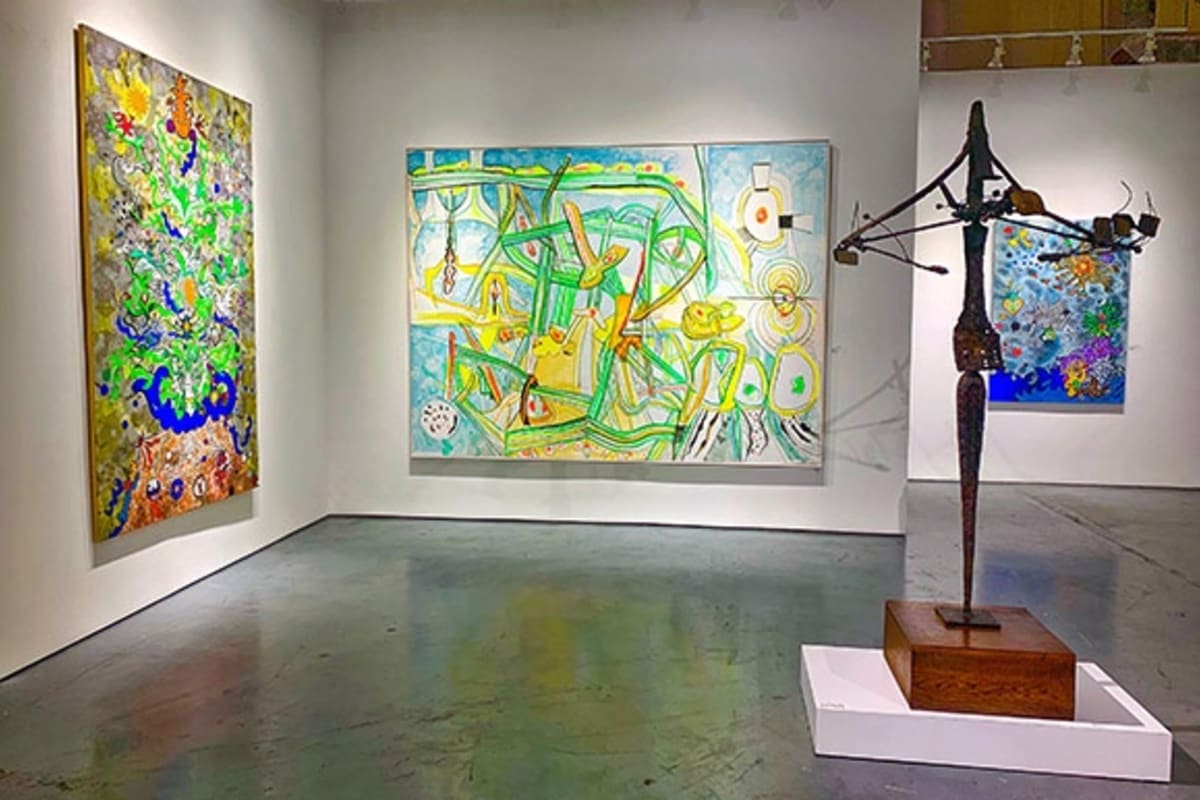
A wavering, wandering line runs through many of Federica Matta's paintings, often traveling in a circle while encompassing any number of fantastic creatures on its journey. "I create passage," she says. "Everything is in motion."i Passage (in French it suggests transition as well as place) was a word that caught the attention of her father, Roberto Matta, when, still in his twenties, he read a 1936 Cahiers d'Art article on Marcel Duchamp by Gabrielle Buffet-Picabia. "For me," Matta recalled, "it was a revelation to understand that an art work could deal with change or passage." A guiding principle of his art became: "Reality can only be dealt with in a state of perpetual transformation. "ii
A similar obsession had an early hold on Federica. Both artists, father and daughter, had an abundance of energy which translated into a heightened response to the momentum of a world in flux. Matta's thinking had its roots in science. Conversant with contemporary physical theory, he was fascinated by the idea that there was no fixed point from which to observe the universe. Ways of dealing with limitless space became his preoccupation. Federica, more focused on the occupants of space, made use of icons or archetypes representing diverse systems of belief and varying forms of social organization. Both veered away from isolated single subjects, portraying instead networks of relationships, whether in cosmic space or in what Matta called "social morphologies." In bringing together the work of these two artists the Boca Raton exhibition offers an exhilarating dialogue between two generations with differing ways of expressing similar insights. Seen in proximity, the artworks cast light on each other.

Roberto Matta's La Terre et Ses Oignons, and Federica Matta's Lemanja and La Carte du Temps in the Two Generations exhibition.
Matta's art is relevant for a global audience since his paintings reveal spaces that extend far beyond the planet and help us intuit our situation in the cosmos. Born into a Chilean family of Basque origins, he grew up in Santiago, a city built on a geological fault. His long, thin homeland, encompassing geysers, volcanoes, deserts, glaciers, wide beaches, and an indigenous population, may have conditioned his awareness and desire to portray a universe perpetually in transition. Apart from the World War II years in the United States his adult life was lived in France, Italy, and England, while his reputation as an artist encircled the globe. Trained as an architect, he served an apprenticeship in Paris with Le Corbusier. Since there was little drafting work in the studio, Matta turned increasingly to improvised drawing, using as a point of departure microscopic photographs of plant life to produce fantastic images of hybrid forms. When Matta joined the Surrealists in 1937 the Surrealist leader, poet Andre Breton, saw these images and asked Matta to contribute drawings to several of his books. Echoes of these botanically inspired forms resurface throughout his career.
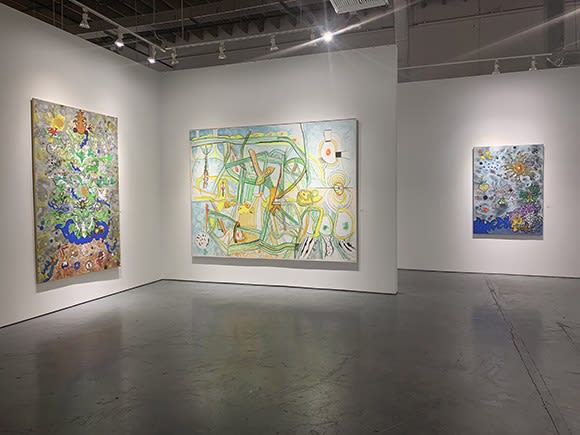 Federica Matta's Les Multiplications, Roberto Matta's Morphologie de l'ame and Federica Matta's Les Voyages in the Two Generations exhibition
Federica Matta's Les Multiplications, Roberto Matta's Morphologie de l'ame and Federica Matta's Les Voyages in the Two Generations exhibition
Federica Matta's heritage combined the New England upbringing of her American mother, Malitte Pope, with the strong Spanish/Chilean background of her father. Her childhood was spent in France and Sicily until her sixteenth year when she was sent to a school in Martinique. There she was deeply influenced by the poet Edouard Glissant. "Martinique was the turning point in my life," she recalls. "There was real intellectual stimulation in that school. What I learned in Martinique was the idea that you do politics with a poetic approach in order to create a space that allows change."
Imprinted on Federica as a child were the sculptural forms of the collapsed volcano crater that cradled their home on the Sicilian Island of Panarea, facing the active volcano Stromboli. Also formative were the many works of tribal art that Matta, like his fellow Surrealists, had avidly collected. Playing among the Malangan carvings, Bambara antelope head dresses, carved fertility figures, and decorated Papuan shields that stood about in her childhood home, she gave them names and regarded them as real. Her father's studio door was closed when he was working, but she remembers walking on canvases on the floor and having access to art supplies to work with on her own. As part of daily life, she lived in the midst of the explosive paintings that were produced behind those studio doors. Just as Matta had moved sideways into art from training in architecture, Federica did not declare a goal of becoming an artist, but began to make art in response to the needs and impulses of her evolving life.
Deeply affected by the deaths of her twin half-brothers, Sebastian in 1976 and Gordon Matta Clark in 1978, she modeled small fantastic creatures into memorial objects. Gradually these began to grow and multiply, becoming necklaces, wall-hung reliefs, sizable sculptures, or parts of an environment. She evolved a repertoire of fantastic images that she uses in paintings, books, and sculpture: winged or multi-armed figures, octopus tentacles, centipedes, comets, stars, bubbles, smiling faces, mermaids, serpents, flames. These swirl through her drawings and paintings, with gravity suspended, as they lead a viewer into the floating worlds of dreams and imagination. Some of her hybrid creatures became maquettes for sizeable sculptures in polyester resin, polystyrene, silicon, and sometimes concrete, enlarged by pantograph in France at the Atelier Gérard Haligon where, for a century, noted sculptors have had their casting and enlarging done.
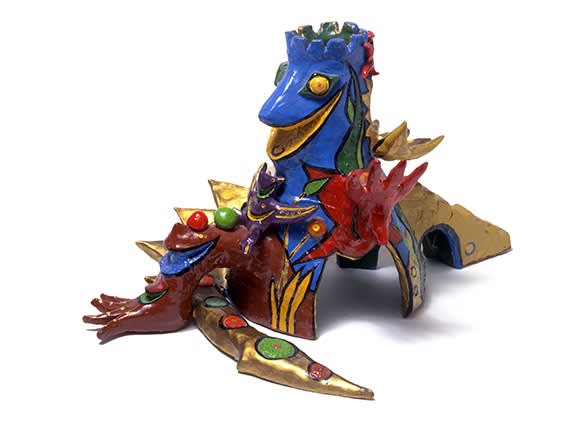
FEDERICA MATTA, Cerro Santa Lucia maquette for La Plaza Brasil
These larger works led Federica to think in terms of environments. Wanting to counter the negative effects of the traumas she had experienced, specifically the Algerian War and the Allende coup in Chile, she felt that there could be an impact made by art in a public space. Following the end of the Pinochet regime in Chile in 1991 she proposed to build sculptures as children’s games in the Plaza Brazil in Santiago.
"In this very sad situation I wanted to create a space where children could do their own artistic self-education, where color and form would activate a common territory where people are in the process of change, a space where you can create passage."
The result is a veritable wonderland in which a park bench is a purple sleeping animal, where a green serpent coils around the support for a swing, and the open jaws of a rainbow-colored dragon invite entry. Experiencing this life-size fantasy world can trigger a free play of the imagination which Federica envisioned as part of the healing process after Chile's traumatic years. Recently the brightly colored surfaces of the playful sculptures in the Plaza Brazil began to show the effects of many years of use. A restoration was undertaken and Federica was invited to Santiago for an official re-opening with city officials attending the public celebration. Clearly it had become a beloved and integral part of the city. After seeing a video showing the delighted expressions of the children at play it is impossible not to wish for a touch of her fantasy in the drab institutional play equipment that adorns most public spaces.
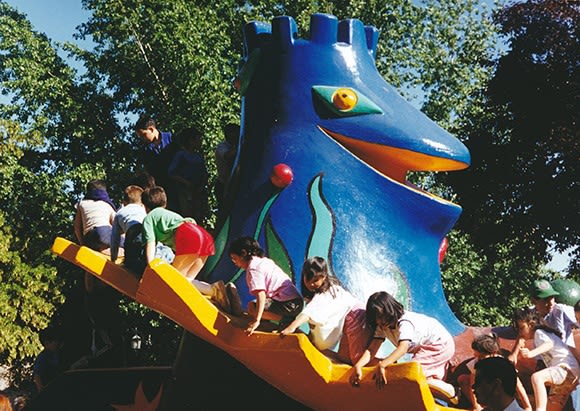
Federica Matta's Cerro Santa Lucia installed in La Plaza Brasil
In 2010 Federica undertook another healing project at the seaport of Saint-Nazaire on the Brittany coast. There, still standing between the town and the sea, is a huge concrete German submarine base, built with labor from concentration camps. To purge the ugly memories the structure perpetuated, Federica made a 24 foot sculpture of Yemanja, an African goddess in the form of a sea creature, that was erected in the city square. It was covered with acrylic and gold leaf, and snakes were coiled on its green-eyed, Medusa-like head. Bursts of blue splashes were fixed in air. When the sculpture was unveiled, a "fete de la Sirene" was held to celebrate her arrival, and the whole city was there. Ten thousand candles were lit in the submarine base to commemorate the slaves that left on the boats from Saint-Nazaire, and music from all the places that Yemanja had visited filled the square. "It was a beautiful night," Federica recalled.
The next morning, she met the mayor in the empty square. "We did it," he said. "We chased away the Nazis."
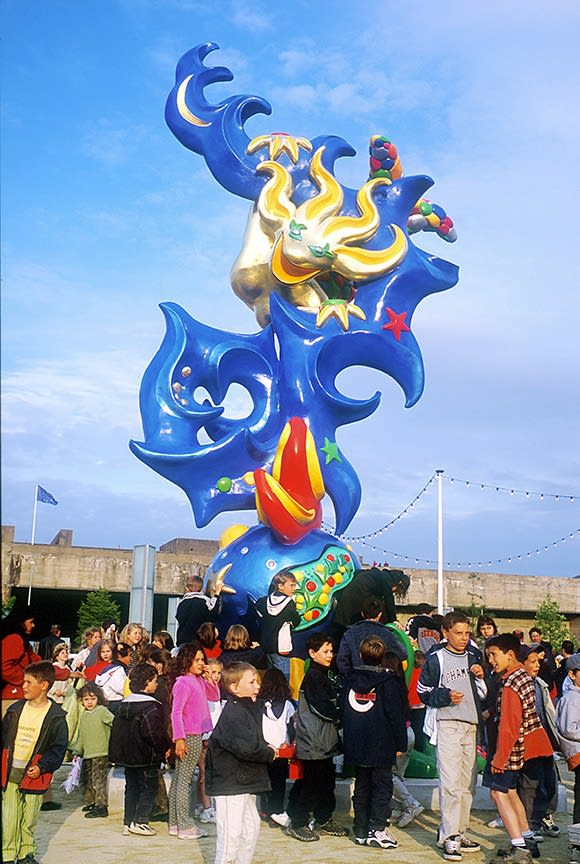
Federica Matta's Le Voyage de la Sirene installed
In 2011 and 2012 she participated in a year-long educational project in Bordeaux. For one week each month she worked with school children creating installations in the alcoves of a former underwater submarine base.
More recently her travels have involved exhibiting her own work and organizing children's workshops to demonstrate the use of her books to inspire self-expression. Her books, Journal Through your Wildest Dreams and Caminando, alternate her drawings and literary quotations with questions on blank pages where readers can draw their answers. El viaje de los imaginarios en 31 dias takes the reader on fantasy voyages complete with maps and descriptions and suggestions for drawing in a journal. These invitations to the imagination speak in a universal language through images that are recognizable as part of a basic vocabulary belonging to myth and folklore around the globe. Her books have been welcomed in workshops, most often in France and South America, but also in India, Japan, Morocco, and Portugal.
In December 2017 Federica returned to Martinique for an exhibition at the Habitation Saint-Etienne, Le Voyage des Imaginaires, in which she paid homage to Edouard Glissant. She drew an imaginary map of the Habitation and wrote of the use of words and images as a means of opening doors to parallel worlds, and she charted the voyage of her siren swimming through the waters of the world from ancient times to the present. Her drawings for the occasion traced a route past erupting volcanoes, deep sea life, turbulence, and calm. Despite the differences in scale and style when it comes to visual portrayal Federica's ultimate reality is close to that of her father, as if their brains had been wired similarly.
In 1976 Matta wrote: "The function of art is to unveil the enormous cultural, economic, and emotional forces that materially interact in our lives and that constitute the real space in which we live."iii
For Matta this meant painting exploding structures on outsize canvases, structures composed of disconnected planes that gave the illusion of complex multi-level spaces. Arrays of detached lines charge the canvas with a sense of energy in motion. Some works referred to specific events like the Viet Nam War, the execution of Julius and Ethel Rosenberg, or fallout from the Franco/Algerian War, while others in a more benign mood dealt with morphology in nature.
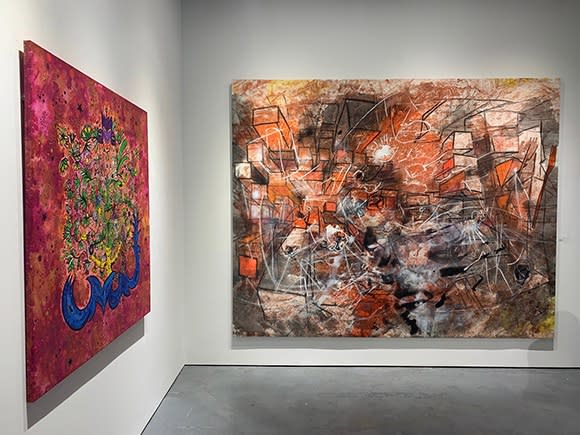
Federica Matta's L'Arbre des Anciens and Roberto Matta's I Saw and Shut the Silence in the Two Generations exhibition
Federica grew up with an understanding of all that Matta's visionary work implied. Her own gift, however, was to understand the power of art to heal wounds, to nurture cohesiveness, and to ease stress though exposure, not only to enlivening images, but also to shapes and colors that quicken the pulse and unleash the imagination.
"I am trying to heal the traumas, to work with the refugees," she says in relation to the current floodtides of displaced people. "We are all in post-traumatic stress." In focusing her efforts on the use of art as a healing force Federica manifests an awareness similar to that of her father, a consciousness that functions on both cosmic and social levels.
"I learned from my father and his friends," she acknowledges. "Matta's art could illuminate issues that would help us save the planet."
i Unless otherwise noted quotations from Federica Matta are from interviews with the author either in person or by phone that took place in September 2018.
ii Matta, Cogitum, exhibition catalogue. (London: Arts Council of Great Britain, 1977), p. 6.
iiiibid.
Martica Sawin
Critic and Art Historian
Martica Sawin has been writing on contemporary art since the 1950s. She is the author of Surrealism in Exile and the Beginning of the New York School and many books and catalogue essays on 20th century artists. From 1968 to 1995 she chaired the art history department at Parsons School of Design and was the founding director of Parsons in Paris.

